Ian Hillery's Trip Report
Trip Report Year:

This tour contains Ian Hillery from UK did a 7 day tour with us in March 2009. He visited 3 main birding sites in Sri Lanka; 1. Sinharaja Rain Forest, 2.Nuwara-eliya highlands and 3.Kithulgala.
This tour report is taken from www.birdseen.co.uk >>
This report consists of 9 parts: Introduction | Day 1 | Day 2 | Day 3 | Day 4 | Day 5 | Day 6 | Day 7 | Species List
you can download the PDF version of the the complete tour report by Ian Hillary here.
Introduction
Located off the South-eastern tip of peninsula India, Sri Lanka offers a mix of typically Asian birds and some of its own endemics. The birding is of a high standard, not so much for the numbers of species to be seen, but the quality of the birds and the views they generally give. For many birders, it is the large percentage of endemic species which is the lure, but this misses a trick, since there are also some excellent non endemics as well. That being said, when birding the island, it is difficult not to get caught up in the chase for all the local specialities, some of which are exceptional in their own right (such as Blue Magpie, Red-faced Malkoha, and who could miss out Junglefowl?).
Sri Lanka is divided into two climatic areas - the wet zone of the South-west, and the dry zone of the rest of the country. With a week on the island, I chose to concentrate on the wet zone area, where the April timing meant comparatively less rain, since the monsoon in this area is towards the end of the calendar year. Focusing on one zone would tend to limit the amount of travel in the time available, and all but one or two of the endemics (Woodshrike and possibly Scarlet-fronted Barbet, if the latter is indeed a true species) are to be found here. Guidance both for locating the birds and navigating the generally unmarked roads means that a guide is almost essential - I chose Prasanjith Caldera, or Jith or short, (see below) who offered a superb service for a personal tour, and at a much more reasonable cost than some of the larger companies (where the birds usually have to be shared between a group). I travelled to Sri Lanka with Kuwait Airways from London Heathrow, refuelling at Kuwait, and Jith was at the airport to pick me up.

www.walkwithjith.com is the website of Jith, who I used as the guide and organiser of the trip. Partly because I was on my own, but mainly due to the country being difficult to negotiate, and the speciality birds even more taxing to track down without local knowledge, I broke with a birding long habit and enlisted help with my trip. My friends and I had come across Jith at the Rutland Water Bird Fair in 2006, and they had subsequently used him the January following. It is difficult to imagine that he has only been organising tours as a business since 2005, even more so when you observe his excellent local knowledge and identification skills.
One of the beauties of Jith's trips is that he will tailor them to your own needs, with a more than reasonable cost. This includes itinerary, driver, accommodation (half board), and entrance fees. He will even alter the itinerary as the trip is under way to react to local and/or bird conditions.
Sites visited / Locations
Sinharaja Man and Biosphere reserve

This is one of the jewels in the crown in nature terms within Sri Lanka. The reserve is set at around 300m above sea level, which is a moderate elevation. It contains mainly tropical rainforest, and this forms part of one of the only remaining tracts of primary forest on the island (although much of the birding is within the adjacent secondary growth). Entrance to the reserve itself is strictly controlled, this being through one port of entry about 2 km above Sinharaja village. A fee is payable, and walking the reserve must be accompanied by a guide. From a birding perspective, there is one main track which runs to and beyond a research station, although there appear to be one or two offshoots which climb through the forest (ascending 740m along a 1km hike).
There is also a walk down from the reserve entrance, which cuts through the forest for around 2 km, ending at the village, where the main reception to Sinharaja is also located. The village is noted for being the more reliable spot for Green-billed Coucal, as well as one two of the more common species, such as Sri Lanka Swallow, which wasn't seen anywhere else in this area.
Nuwaraeliya
Located in the mountains at around 2000 metres, Nuwaraeliya is the town where we were based, and from which some of the higher elevation birds were sought. Temperatures were much more temperate here, being almost jumper cool in the morning and evening, although normal daytime was still quite hot:
Victoria Park
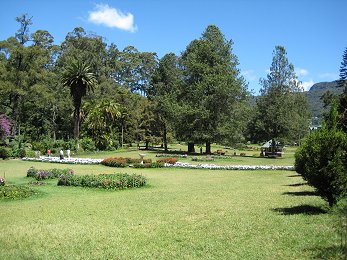
Located within the town itself, this is a contained entrance fee park which is well used by the locals (and presumably tourists in season). It contains tracts of lawn, interwoven with paths, bushes, and a stream along its length. There is a reasonable selection of common birds within the park, but it can also offer Pied Thrush in the winter months.
Nuwaraeliya mixed forest

Found by taking a track from the head of the lake and past vegetable gardens, this is home to many of the higher elevation specialities, prime of which is Sri Lanka Bush-Warbler, which must be hunted for at ground level within the forest and with some patience. Really good news is that there are no leeches at this altitude!
Hakgala Botanical Gardens
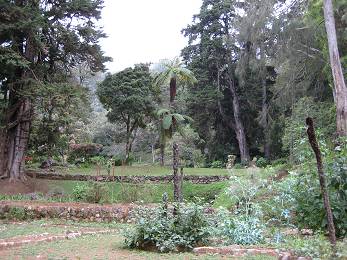
These were kindly established in 1860 by the British who, with tremendous foresight, premonitioned the interest the site would engender for 21st Century birders. As with most other botanical gardens, these are a popular tourist and visitor spot. However, when we were there, most of these people congregated at spots not far from the entrance. The gardens are located on a slope, with footpaths meandering up along through the artificially created vegetation. The good news is that the birds do not necessarily favour a more natural environment, making this a particularly good spot for flycatchers amongst others.
Between the gardens and the town is a reliable spot for Sri Lanka Whistling Thrush. It is set on the corner of the road, adjacent to a vegetable stall. Just below this is a stream and poorly defined waterfall - ideal habitat for the birds, despite the constant comings and goings of the locals. Best views we had were at first light next to the stall - don't be put of by ghostly voices from within, since the stall seems to double as a home!
Kitungala
This village is situated at approximately the same altitude as Sinharaja, and offers a similar selection of birds, although one or two of the specialities are only really available at Sinharaja. The temperature seems to be slightly higher and more sapping at Kitungala, and with the rain showers less predictable. The forest is the main habitat, but the land around Sisira's River Lodge is varied and has an impressive selection of birds:
Sisira's River Lodge
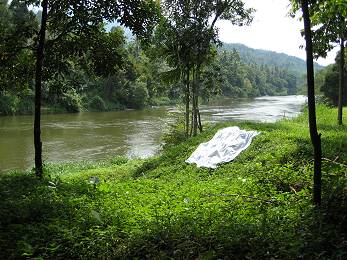
View from Sisira's River Lounge restaurant area
The buildings are loosely connected, and are built in as more or less a part of the surrounding forest. This woodland, and ultimately forest, abuts both banks of the fairly impressive river flowing through. A walk up the track from the lodge finds a clearing next to the police station, and there are impressive views of the surrounding mountains from here. Diverting left on ascending the track through one of the driveways finds a small gate to the wetter small meadows/paddies, which are bisected by a rough path used by the locals. Within a stone's throw of my room, I saw Chestnut-backed Owlet, Layard's Parakeet, Sri Lanka Grey Hornbill, Brown-headed Barbet, and Lesser Goldenback amongst a host of other tasty birds.
Kitungala Forest

Kitungala Forest from village area
Despite having the reputation for a similar array of birds to Sinharaja, the birding here is of a very different nature. To enter the forest proper, the length of the village has to be negotiated first, which can have its own avian rewards. The downside for the visitor is that an electricity supply has led to music and television - not a hearty background for the ardent naturalist. It does provide feeding and nesting for a variety of species, and they can be easier to see than in the denser forest. The latter is found by walking beyond and slightly upwards from the end of the village. Our visit found it quiet for birds, but it would seem the usual rules of forest birding - patience, time and neck breaking observation - are needed for the best catch.
Accommodation
Martin's Lodge

This is the only accommodation which adjoins the Sinharaja Reserve, so much so that the entrance is only a 100 metre walk from the door of the bedroom. The next closest accommodation is at the main reception to the park, which is a 4x4 vehicle drive about 1 km down from the entry post. Martin has built the premises up more or less from scratch. There are 6 twin rooms, and a dormitory for 10 sharing.
My room was very basic but more than adequate for a birding stay, with shelves for gear, and a single socket for charging up the weight of equipment which seems necessary for 21st century birding. The food is naturally made on the premises, and was a great experience, if basic. They must have thought I needed feeding, if the number of dishes with varying contents just for me was an indication. Suffice to say that I thoroughly enjoyed the variety of fare on offer. They also tried palming me off with the western breakfast of omelette and toast, until I rapidly discovered that the kitchen could be raided for early morning curry. The room had one electricity socket which was of the Indian type D variety.
Alpine Lodge, Nuwaraeliya

There seems to be a profusion of accommodation in Nuwaraeliya, ranging from individual B&B's to the largest hotel which is the Indian Grand. The Alpine Hotel is more than adequate, being of a medium size, and having comfortable appointment. My room was actually quite large, with king sized bed and even a TV. There are no birds on the doorstep, since the building is in a loosely residential area, but the lake and Victoria Park are only a 5 minute walk away. Evening meal seemed to have a set menu choice, which looked a little pan-European, but I asked for something more Sri Lankan and received a treat of a feast. The room had 2 types of sockets - UK square pin and South African round pin.
Sisira's River Lodge, Kitungala
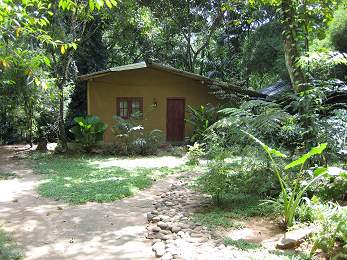
The location of the lodge is ideal for birding - within an area of woodland, adjacent to a river on one side, and clearings with gardens and slightly marshy small meadows on the other. My room was standalone, and had a balcony which overlooked the river. There were 2 single beds in a reasonable sized room, but the best part was the bathroom - open air, with a shower that was more of a mini-waterfall. The restaurant is also open air, and the food Sri Lankan style and of good quality. I had two electricity sockets in the room, both taking type D Indian plugs.
Tips
- Take leech socks - the little parasites are abundant on the lowland rainforest. I found that a combination of the socks, 50% deet gel on the exposed legs, and 50% deet spray around the shoes was sufficient to allow shorts to be worn, resulting in only one successful bite during the whole week
- Temperatures are generally high, but early morning and late afternoon in the mountains (such as at Nuwaraeliya) are cool enough for a jacket or fleece
- An umbrella and/or rain mac are essential. Despite being there in the dry season, the area I visited is the wet zone, which usually meant sunny mornings and partially wet afternoons
- For those with the modern plethora of rechargeable toys, such as digital cameras, mobile phones, etc, it is worth taking a variety of adapter plugs. I found a combination of Indian type D, UK square pin, and South African round pin to be used. The European two pin is also supposed to fit, but would need a larger earth pin included to unlock the females in the wall socket
- Sri Lankan food is very good, but some places try to adapt to the British palate. It is worth asking for a Sri Lankan meal - the Alpine Hotel tend to have a European menu as standard unless asked, and Martin's Lodge will proffer omelette and toast for breakfast unless the kitchen is raided for curry
References
For identification, “A Field Guide to the Birds of Sri Lanka” by John Harrison (published by Oxford University Press) is ideal, with good illustrations and reasonable text. The island is also covered as part of “The Guide to the birds of the Indian Subcontinent” by Inskipp, Inskipp, and Grimmett, but it is not quite as easy to tease out the Sri Lankan birds from the larger numbers of the mainland.
“The Photograhic Guide to the Snakes and other Reptiles of Sri Lanka” by Indraneil Das and Anslem de Silva (New Holland Publishers Ltd) is also very useful, since some should be encountered during a trip.
This report consists of 9 parts: Introduction | Day 1 | Day 2 | Day 3 | Day 4 | Day 5 | Day 6 | Day 7 | Species List

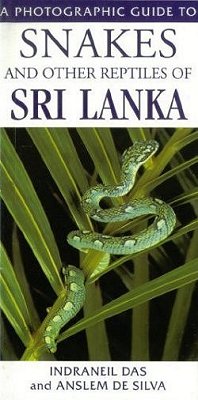
Country:
- Log in to post comments

















